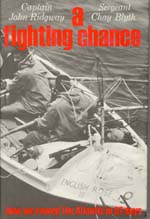A Fighting Chance
Created | Updated Jul 23, 2003
Written by John Ridgway and Chay Blyth and published by Paul Hamlyn in 1966 and Pan Paperback in 1968 (OUT OF PRINT)

“The winds built up till it was gale force. We have been using the jets and props going to Shannon as a guide. We can’t be far away now. All day we hear them. I was rowing about 0900 hours; John was making breakfast. He stood up. ‘Land’ he said. I wouldn’t look. ‘I’ll wait till we get closer’, I said. The weather closed in then. We worked out it could only be the Aran Islands. The rain started to pour down. Both oars came out. We had approximately nine hours of daylight left. The seas were getting bigger all the time. About 1400 hours we could make out the cliffs. I started preparing the packs for an emergency landing. We were both singing now. I believe we hadn’t come 3,000 miles to find death on a cliff.” (From Chay Blyth’s log book).
On that stormy Saturday in September John Ridgway and Chay Blyth landed at the little Irish village of Inishmore after rowing alone across the Atlantic in a tiny boat only twenty feet long and five feet wide.
Their 92-day voyage from Cape Cod was an incredible achievement. Both Captain Ridgway and Sergeant Blyth had a tough army training as paratroopers, but neither had much experience of the sea. The little boat, English Rose III, was like a Nova Scotian dory – the sort of open boat traditionally used by fishermen off the coast of North East America. The dory men who made her ready promised the two Englishmen ‘a fighting chance’ – and they certainly needed it.
For three months they lived in a cockpit measuring eight feet by four feet. English Rose III was battered by storms, by hurricane Alma, by huge and almost over-whelming waves. Salt water got into the rations and food became short. The rowers encountered whales, sharks, porpoises, dolphins, a mysterious sea serpent and the occasional friendly ship. But the intense solitude brought a new dimension to life, and the struggle to keep going and keep alive gave them a greater awareness of true values.
Day by day, John Ridgway and Chay Blyth kept individual logs, recording their experiences. These salt-stained notebooks have enabled them to write A Fighting Chance, their own personal account of an achievement which must surely rank as one of the great heroic adventures of the 20th century.
The book includes a list of equipment taken on the voyage of English Rose III and an account of the navigation methods used. It is illustrated with photographs taken by the authors and facsimile pages from their log books.
Postscript in 2003 by John RidgwayThis was a hard trip for two young fellows. It was not simply being in a small open boat in miserable conditions for three months…though I do remember we had no sleeping bags or bedding, and we sucked boiled sweets through their wrapping paper when the food began to run out. But mostly I remember David Johnstone and John Hoare, who were making the same voyage that year. They set out a few days before us, from Norfolk Virginia. Months later their upturned boat was found in the middle of the North Atlantic. They have been dead for nearly 37 years now. I have tried to look on every day since that voyage as a bonus. It could so easily have been the two of us who died. This voyage changed the course of our lives.
Back to Publications by the Ridgways of Ardmore
